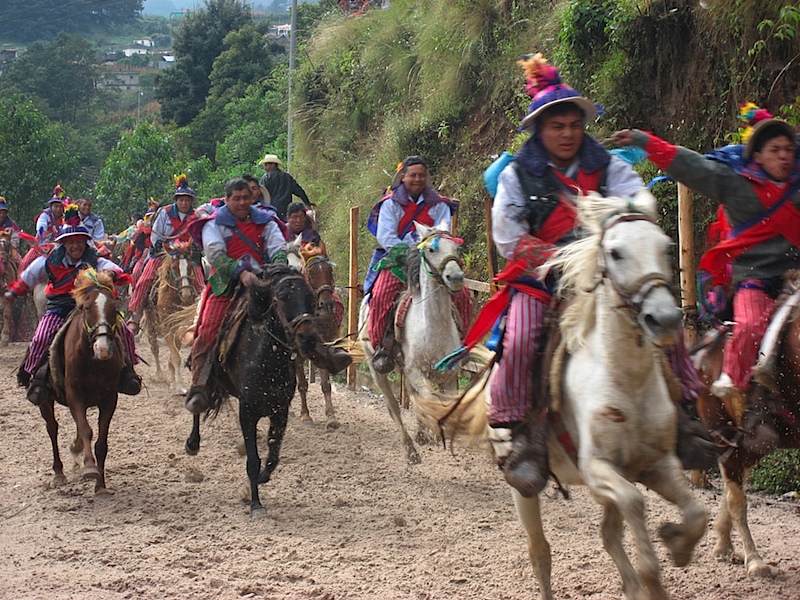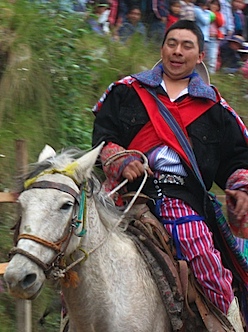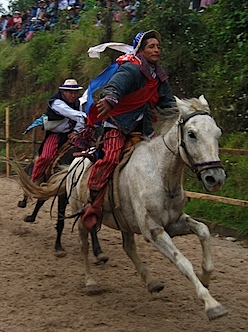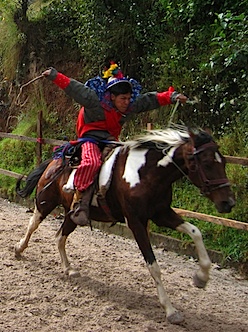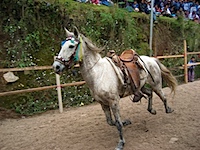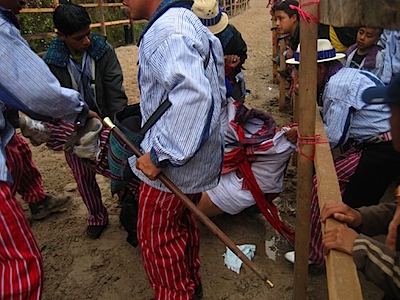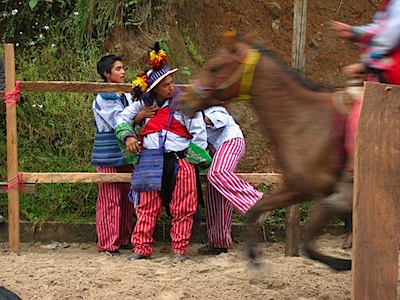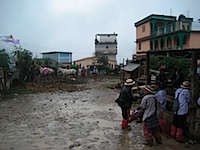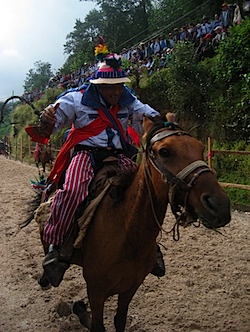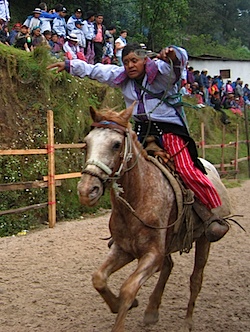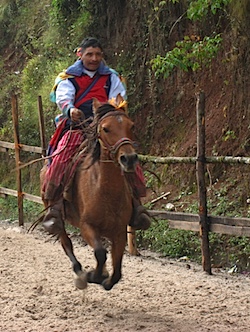Yesterday was All Saints Day, known to many of us only because it is the day after Halloween. Catholics know otherwise; they have lots of saints and each one gets his (or her) day. This is important, because in Guatemala nearly every town is named after a saint, and on that saint’s day the town holds its feria, or festival. For example, our nearest town is called Santa Eulalia, and we have our town feria every February on Saint Eulalia’s day. But All Saints Day is special, because it’s a sort of bonus day to honor ALL the saints in the pantheon, including those minor ones that might have otherwise been forgotten. So who has their feria on that day? You guessed it, the town of Todos Santos (All Saints).
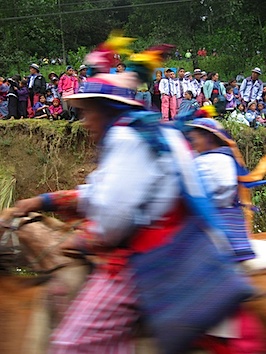 I like Todos Santos for a lot of reasons: the Mayans that live there are ethnically really close to the Q’anjob’al we live with, they are situated in a highland mountain range just like us, and they have the same cold, rainy weather. But Todos Santos is also one of the most famous towns in Mayan Guatemala, for two reasons. First, they are one of the few Mayan groups to stick tenaciously to their ancient traje (clothing). Their distinctive red-and-white striped pants, together with their wide-collared blue-and-white shirts, are very distinctive and can identify a Todos Santero anywhere in Guatemala. During the civil war, many indigenous groups abandoned their traditional dress to avoid being singled out and persecuted, but the Todos Santeros refused to yield… and many of their tribe paid the ultimate price. Today, every one of them proudly wears their colors from a very young age.
I like Todos Santos for a lot of reasons: the Mayans that live there are ethnically really close to the Q’anjob’al we live with, they are situated in a highland mountain range just like us, and they have the same cold, rainy weather. But Todos Santos is also one of the most famous towns in Mayan Guatemala, for two reasons. First, they are one of the few Mayan groups to stick tenaciously to their ancient traje (clothing). Their distinctive red-and-white striped pants, together with their wide-collared blue-and-white shirts, are very distinctive and can identify a Todos Santero anywhere in Guatemala. During the civil war, many indigenous groups abandoned their traditional dress to avoid being singled out and persecuted, but the Todos Santeros refused to yield… and many of their tribe paid the ultimate price. Today, every one of them proudly wears their colors from a very young age.
Todos Santos’s second claim to fame is its horse race. And that is the subject of this post.
Now, when I say “horse race,” that doesn’t exactly explain it. Yes, there are horses, and they do race around, but there really isn’t a winner. In fact, the competitors enter and exit the race throughout the day. Oh, that’s another thing- it runs ALL DAY LONG. Back and forth, along a flat stretch of land maybe a quarter-mile long.
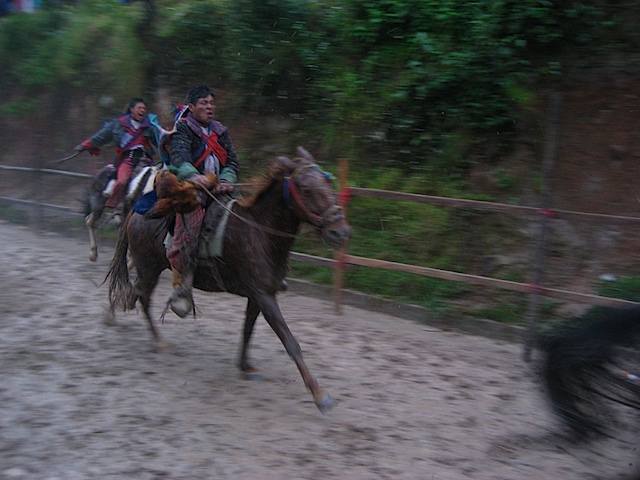 There is a story that the races originated shortly after the Spanish invasion in the 16th century. According to legend, the Spanish conquistadores told the Todos Santeros that they were stupid indians, and could never ride anything as beautiful as a horse and they were only good enough to raise roosters for cockfighting. These proud and brave Mayans felt otherwise, and taught themselves to ride. Every year for centuries, they have continued to display their riding prowess at the festival, to honor their ancestors and defy those who enslaved them. To drive the point home, they run the last few races of the day using live roosters in place of riding crops, ending in the deaths of the roosters.
There is a story that the races originated shortly after the Spanish invasion in the 16th century. According to legend, the Spanish conquistadores told the Todos Santeros that they were stupid indians, and could never ride anything as beautiful as a horse and they were only good enough to raise roosters for cockfighting. These proud and brave Mayans felt otherwise, and taught themselves to ride. Every year for centuries, they have continued to display their riding prowess at the festival, to honor their ancestors and defy those who enslaved them. To drive the point home, they run the last few races of the day using live roosters in place of riding crops, ending in the deaths of the roosters.
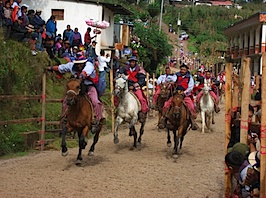 If that wasn’t enough, another important part of the race is that every rider must be thoroughly intoxicated. When I first heard this, I thought it sounded like pure stupidity, another sad example of how alcoholism is a grave and ever-present problem in Guatemala. But it’s more complicated than that. Each rider represents a respected family in Todos Santos, and each of these families sends the rider as a sort of human sacrifice. They are dressed in their finest costuming, adorned with feathers and streamers and banners of hidden significance, and sent out to the race as an offering to the gods. Much like peyote for some North American native tribes, the alcohol eases their path into the metaphysical realm, where they race on a plane that is not quite a part of this world.
If that wasn’t enough, another important part of the race is that every rider must be thoroughly intoxicated. When I first heard this, I thought it sounded like pure stupidity, another sad example of how alcoholism is a grave and ever-present problem in Guatemala. But it’s more complicated than that. Each rider represents a respected family in Todos Santos, and each of these families sends the rider as a sort of human sacrifice. They are dressed in their finest costuming, adorned with feathers and streamers and banners of hidden significance, and sent out to the race as an offering to the gods. Much like peyote for some North American native tribes, the alcohol eases their path into the metaphysical realm, where they race on a plane that is not quite a part of this world.
As I pushed my way through the red and blue crowd, I noticed a great many Gringo faces as well. The races at Todos Santos are well-known in tourist circles, and a great many foreigners turn out. I saw Germans, Canadians, Englishmen, even a photographer from the Reuters news service(1). Then I saw a face I recognized, and stopped short: Steve McFarland, the American ambassador to Guatemala.
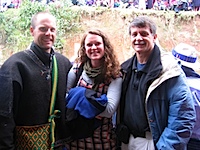 I have met the Ambassador before, and I think highly of the man. He is amiable, well spoken, and very intelligent. He works hard in the service of his country, and also cares a lot about Guatemala. It sounds silly, but he makes me proud of America. He speaks perfect Spanish and is learning Quiché, one of the Mayan languages; not because he needs to, but because he wants to. For him to show up to traditional cultural things like the Todos Santos feria just reinforces my idea that this guy is the Real Deal. As we watched the race, Emily and the ambassador discussed the role of bilingual education in the Guatemalan school system, and the usefulness of English to the few Mayan women that are able to go beyond high school education.
I have met the Ambassador before, and I think highly of the man. He is amiable, well spoken, and very intelligent. He works hard in the service of his country, and also cares a lot about Guatemala. It sounds silly, but he makes me proud of America. He speaks perfect Spanish and is learning Quiché, one of the Mayan languages; not because he needs to, but because he wants to. For him to show up to traditional cultural things like the Todos Santos feria just reinforces my idea that this guy is the Real Deal. As we watched the race, Emily and the ambassador discussed the role of bilingual education in the Guatemalan school system, and the usefulness of English to the few Mayan women that are able to go beyond high school education.
The Peace Corps is officially under the jurisdiction of the US Ambassador in every country we work in. I imagine that in some countries, this is simply an administrative convenience. But in Guatemala, the Ambassador and the Peace Corps have a really good working relationship. He is one of our biggest supporters, and makes a point to drop in on Peace Corps volunteers regularly as he moves throughout Guatemala. He takes the time to listen to our perspective on what’s really going on. I don’t delude myself into thinking that our input makes major policy impact, but I imagine that we DO give him a perspective on what’s really happening amongst the common folk in Guatemala that is not readily available to his embassy staff living in their secure compounds in the capitol. For me, it’s really moving that he cares about us and his work enough to take time to talk with us one-on-one.
And if I didn’t already like the guy enough, right after he left I got news that that he brought five plates of brownies for all the PCVs present. Man, they were good. Steve, if you’re reading this, thank you and please send the recipe.
By this time, the races were in full swing. The pack thundered by us with occasional whoops from the riders. You can see a video of it here. I soon grew fond of three of the riders, who in my head I named “El Chino”, “The Old Guy”, and “The Serious Guy.” Here they are, in all their glory.
Even though the point wasn’t to “get there first,” it was all galloping, all the time. Some riders lifted their arms like birds: enjoying the ride, or the crowd, or maybe their journey through the spirit world. Some wore smiles of contentment, waiting to see what their fate would be. For some, the fate wasn’t good. At one point, I saw a horse running with no rider. “He fell off at the other end,” I heard someone in the crowd say.
We saw several more riderless horses that day. Luckily, the horses weren’t drinking, and sober horses make excellent Designated Drivers. We didn’t see a single horse-to-horse collision all day, though there WAS a close call when a rider started really late from the gate after the main group had already started back. I heard the entire crowd suck in their breath as he shot head-on through the middle of the galloping herd bearing down on him. Most of the rider accidents that happened seemed to be near the end of a run as the horses started slowing down- and the rider didn’t. This poor fellow got lucky, and fell off when his horse had nearly stopped. I think he is unconscious from the alcohol, not the impact, and will live to ride again next year. The other guy fell off and was able to right himself under his own steam, but his buddies had to restrain him from trying to go get his horse while the rest of the herd was galloping down the track.
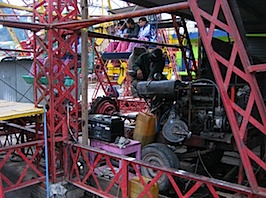
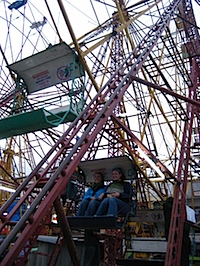 Around noon, the riders and crowd took a two-hour lunch break. This was our cue to get some food as well, and to look at other things going on at the feria. Emily thought she’d try out the Ferris wheel. I like Ferris wheels, but the prospect of riding one at a carnival in Guatemala strikes me as …well.. about as dangerous as riding a horse while intoxicated. Check out the mechanism that runs this thing: it’s the engine and drivetrain from a school bus, complete with clutch, gearshift, and air brakes. The PTO is connected to a set of idler wheels and some steel cable to turn the Ferris wheel. Yikes. But Emily wouldn’t be deterred, perhaps in homage to Mr. George Ferris, the contraption’s inventor and local hero of her college town of Galesburg, Illinois.
Around noon, the riders and crowd took a two-hour lunch break. This was our cue to get some food as well, and to look at other things going on at the feria. Emily thought she’d try out the Ferris wheel. I like Ferris wheels, but the prospect of riding one at a carnival in Guatemala strikes me as …well.. about as dangerous as riding a horse while intoxicated. Check out the mechanism that runs this thing: it’s the engine and drivetrain from a school bus, complete with clutch, gearshift, and air brakes. The PTO is connected to a set of idler wheels and some steel cable to turn the Ferris wheel. Yikes. But Emily wouldn’t be deterred, perhaps in homage to Mr. George Ferris, the contraption’s inventor and local hero of her college town of Galesburg, Illinois.
On the way back to the horses, we passed the “pit” area. Here we see the waiting replacement horses, as well as some villagers dancing to the marimba that is being played under a tin roof (click to enlarge).
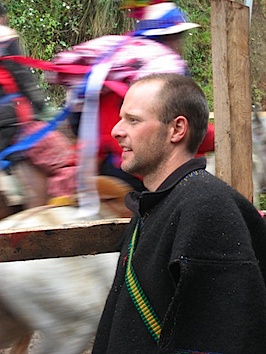 I spent much of the day right next to the track, watching the powerful and beautiful display of horse and man. The crowd milled around me, occasionally cringing as mud and sand sprayed us from the pounding hoofs. I was wearing my capishay, the traditional Mayan half-cape that is native to our village, to ward off the cold and misty rain. I felt a tug on my sleeve, and turned to see a very old Mayan lady, weathered with age.
I spent much of the day right next to the track, watching the powerful and beautiful display of horse and man. The crowd milled around me, occasionally cringing as mud and sand sprayed us from the pounding hoofs. I was wearing my capishay, the traditional Mayan half-cape that is native to our village, to ward off the cold and misty rain. I felt a tug on my sleeve, and turned to see a very old Mayan lady, weathered with age.
“Where did you get that beautiful capishay?” she asked, raising her eyebrows. She was the first of several that asked me that.
I smiled. “In my village. Near Santa Eulalia,” I responded, suddenly and unexpectedly filled with pride for my Q’anjob’al people.
She sighed, a mixture of sadness and fond recollection. “That’s too bad, I was hoping you’d bought it here. They used to wear those here, too, you know. Back when I was young. I was hoping someone had started making them again.”
But that is the sad truth of it; the Mayans are losing their culture bit by bit, a seemingly irreversible erosion into the sea of memory and modernity. Even in Todos Santos, stronghold of traditional dress, the tide is irreversible. I regretfully told her that there is only one man left in Santa Eulalia that still makes them, and he is getting old too.
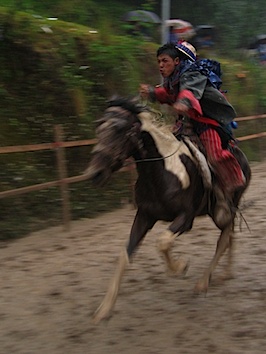 As the afternoon wore one, the mood changed. What was once a festival had become a sort of desperate struggle. The riders were more intense, the horses were running faster. It was like a storm brewing; something was going to happen. The only question was when. Riders whipped their horses onto faster speeds, and the mounts eagerly accepted the challenge. Some rode with their eyes closed, some flapped their arms like birds, others had faces twisted into masks of ecstasy. The energy was palpable.
As the afternoon wore one, the mood changed. What was once a festival had become a sort of desperate struggle. The riders were more intense, the horses were running faster. It was like a storm brewing; something was going to happen. The only question was when. Riders whipped their horses onto faster speeds, and the mounts eagerly accepted the challenge. Some rode with their eyes closed, some flapped their arms like birds, others had faces twisted into masks of ecstasy. The energy was palpable.
Emily turned to a striped-pants wearing Santero, and asked, “So, do riders die sometimes?” We had heard that every few years someone did, and it was part of the ritual. The possibility of death, the chance of avoiding it. Putting your life in the hands of the gods.
“Oh yes,” he affirmed, popping another french fry into his mouth. “It’s good for business.”
I raised my eyebrow. “Really? I heard that it was good for the crops.”
He nodded. “Yeah, that too. But it’s really good for business.”
“For the guy’s family, you mean,” I answered. He looked confused. “The dead rider probably doesn’t see much extra business,” I clarified.
He laughed. “I guess you could say that!”
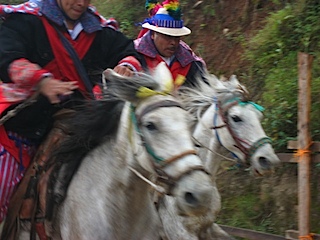 But that is what it’s all about. The race is not a competition, it’s a religious experience. Every one of the riders faces possible death, a willing sacrifice for the good of the community. A human sacrifice, to please ancient Mayan gods. Do they fear this death? It’s hard to know. They are very stoic, and the respected men of the community rise to this responsibility. The riders fly by, their faces a mix of emotions: some elated, some near tears, some bent intensely on going as fast as they can…perhaps even fast enough to outrun their own fate.
But that is what it’s all about. The race is not a competition, it’s a religious experience. Every one of the riders faces possible death, a willing sacrifice for the good of the community. A human sacrifice, to please ancient Mayan gods. Do they fear this death? It’s hard to know. They are very stoic, and the respected men of the community rise to this responsibility. The riders fly by, their faces a mix of emotions: some elated, some near tears, some bent intensely on going as fast as they can…perhaps even fast enough to outrun their own fate.
“I don’t think I believe in anything enough to die for it,” our friend Ann mused.
A sudden WHUMP interrupted my response. A rider had slumped sideways down his saddle, hanging off the side of his horse at full gallop. As the pack passed where we were standing, his face connected with one of the wooden fence posts. He was stripped from his horse with a sickening, gut-wrenching crunch and wrapped around the next post. The horse and rider behind him leaped clear over the spinning body, and we were left looking at a badly twisted, unmoving corpse.
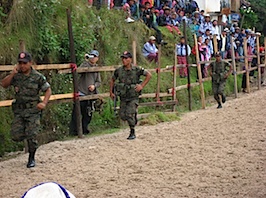 “Oh my god,” Ann said, turning around. By then, several Mayan men were on the track, some waving the other thundering riders away from the fence, others grabbing the body to carry it off. Some Guatemalan army soldiers, loitering for the riot that everyone expects but never happens, came running up to offer whatever aid they could. “We should probably go,” Emily said, and we moved away as a white woman with a fancy camera moved into get some pictures of the carnage. We all shook our heads; that isn’t right.
“Oh my god,” Ann said, turning around. By then, several Mayan men were on the track, some waving the other thundering riders away from the fence, others grabbing the body to carry it off. Some Guatemalan army soldiers, loitering for the riot that everyone expects but never happens, came running up to offer whatever aid they could. “We should probably go,” Emily said, and we moved away as a white woman with a fancy camera moved into get some pictures of the carnage. We all shook our heads; that isn’t right.
As we walked back to our friend’s house half an hour later, Emily tugged my shirt. “That’s him!” she whispered. “In the red boots. That’s the guy that we thought was dead.”
Sure enough, there he was, staggering toward town with the rest of the crowd. Just walking, with the rest of us. He shambled as he stepped, his hair was matted with blood, but he was walking.
The Mayan gods had decided that today was not his day.
1: The Reuters reporter has a slightly different outlook on what the races are about, especially in terms of alcohol consumption. Though many of his comments are valid, I feel like he missed much of the point, perhaps because he’s not very familiar with the more spiritual aspects of Mayan culture.
As with most of these entries, you can click on pictures to get a higher-resolution version. A lot of these pictures are cool (IMHO) so I uploaded them at a higher-than-normal resolution.
